Placeholder class that outlines the functions provided by FaceNumbering<dim, subdim>. More...
#include <triangulation/detail/facenumbering.h>

Static Public Member Functions | |
| static constexpr Perm< dim+1 > | ordering (int face) |
| Given a subdim-face number within a dim-dimensional simplex, returns the corresponding canonical ordering of the simplex vertices. | |
| static constexpr int | faceNumber (Perm< dim+1 > vertices) |
| Identifies which subdim-face in a dim-dimensional simplex is represented by the first (subdim + 1) elements of the given permutation. | |
| static constexpr bool | containsVertex (int face, int vertex) |
| Tests whether the given subdim-face of a dim-dimensional simplex contains the given vertex of the simplex. | |
Static Public Attributes | |
| static constexpr int | oppositeDim = (dim - 1 - subdim) |
| The dimension of the faces opposite these in a top-dimensional simplex of a dim-dimensional triangulation. | |
| static constexpr bool | lexNumbering = (subdim <= oppositeDim) |
true if faces are numbered in lexicographical order according to their vertices, or false if faces are numbered in reverse lexicographical order. | |
| static constexpr int | nFaces = binomSmall(dim + 1, lexDim + 1) |
| The total number of subdim-dimensional faces in each dim-dimensional simplex. | |
Static Protected Attributes | |
| static constexpr int | lexDim = (lexNumbering ? subdim : oppositeDim) |
| Whichever of subdim or oppositeDim uses lexicographical face numbering. | |
Detailed Description
class regina::detail::FaceNumberingAPI< dim, subdim >
Placeholder class that outlines the functions provided by FaceNumbering<dim, subdim>.
This class exists mainly to help with documentation.
The class FaceNumbering<dim, subdim> details how the subdim-faces of a dim-dimensional simplex are numbered. Its implementation involves many template specialisations, and so this base class FaceNumberingAPI serves to put all the documentation and class constants in one place.
End users should access the numbering scheme through either FaceNumbering<dim, subdim> or its child class Face<dim, subdim>. There is no need to refer to FaceNumberingAPI directly.
The member functions described here are never implemented in the base class FaceNumberingAPI; instead they are redeclared and implemented in the various specialisations of the child class FaceNumberingImpl.
See the FaceNumbering template class notes for further information, including details of how the face numbering scheme works.
- Python
- This base class is not present, and neither is FaceNumbering<dim, subdim>. Python users can access these routines through the class Face<dim, subdim> (which in Python becomes Facedim_subdim, or one of the type aliases such as Vertex3, Edge2 and so on).
- Template Parameters
-
dim the dimension of the simplex whose faces are being numbered. This must be between 1 and 15 inclusive. subdim the dimension of the faces being numbered. This must be between 0 and dim-1 inclusive.
Member Function Documentation
◆ containsVertex()
|
staticconstexpr |
Tests whether the given subdim-face of a dim-dimensional simplex contains the given vertex of the simplex.
- Parameters
-
face a subdim-face number in a dim-simplex; this must be between 0 and (dim+1 choose subdim+1)-1 inclusive. vertex a vertex number in a dim-simplex; this must be between 0 and dim inclusive.
- Returns
trueif and only if the given subdim-face contains the given vertex.
◆ faceNumber()
|
staticconstexpr |
Identifies which subdim-face in a dim-dimensional simplex is represented by the first (subdim + 1) elements of the given permutation.
In other words, this routine identifies which subdim-face number within a dim-dimensional simplex spans vertices vertices[0, ..., subdim].
For the special case subdim == 1 (i.e., edges in a dim-dimensional simplex), you can also call this function in the form faceNumber(u, v), where u and v are two distinct vertex numbers in the range 0 ≤ u,v ≤ dim: this will return the number of the edge spanned by simplex vertices u and v. It does not matter whether u is smaller or larger than v.
- Parameters
-
vertices a permutation whose first (subdim + 1) elements represent some vertex numbers in a dim-simplex.
- Returns
- the corresponding subdim-face number in the dim-simplex. This will be between 0 and (dim+1 choose subdim+1)-1 inclusive.
◆ ordering()
|
staticconstexpr |
Given a subdim-face number within a dim-dimensional simplex, returns the corresponding canonical ordering of the simplex vertices.
If this canonical ordering is c, then c[0,...,subdim] will be the vertices of the given face in increasing numerical order. That is, c[0] < ... < c[subdim]. The remaining images c[(subdim + 1),...,dim] will be ordered arbitrarily.
Note that this is not the same permutation as returned by Simplex<dim>::faceMapping<subdim>():
- ordering() is a static function, which returns the same permutation for the same face number, regardless of which dim-simplex we are looking at. The images of 0,...,subdim will always appear in increasing order, and the images of (subdim + 1),...,dim will be arbitrary.
- faceMapping() examines the underlying face F of the triangulation and, across all appearances of F in different dim-simplices: (i) chooses the images of 0,...,subdim to map to the same respective vertices of F; and (ii) chooses the images of (subdim + 1),...,dim to maintain a "consistent orientation" constraint.
- Parameters
-
face identifies which subdim-face of a dim-dimensional simplex to query. This must be between 0 and (dim+1 choose subdim+1)-1 inclusive.
- Returns
- the corresponding canonical ordering of the simplex vertices.
Member Data Documentation
◆ lexDim
|
staticconstexprprotected |
Whichever of subdim or oppositeDim uses lexicographical face numbering.
◆ lexNumbering
|
staticconstexpr |
true if faces are numbered in lexicographical order according to their vertices, or false if faces are numbered in reverse lexicographical order.
◆ nFaces
|
staticconstexpr |
The total number of subdim-dimensional faces in each dim-dimensional simplex.
◆ oppositeDim
|
staticconstexpr |
The dimension of the faces opposite these in a top-dimensional simplex of a dim-dimensional triangulation.
The documentation for this class was generated from the following file:
- triangulation/detail/facenumbering.h
Copyright © 1999–2025, The Regina development team